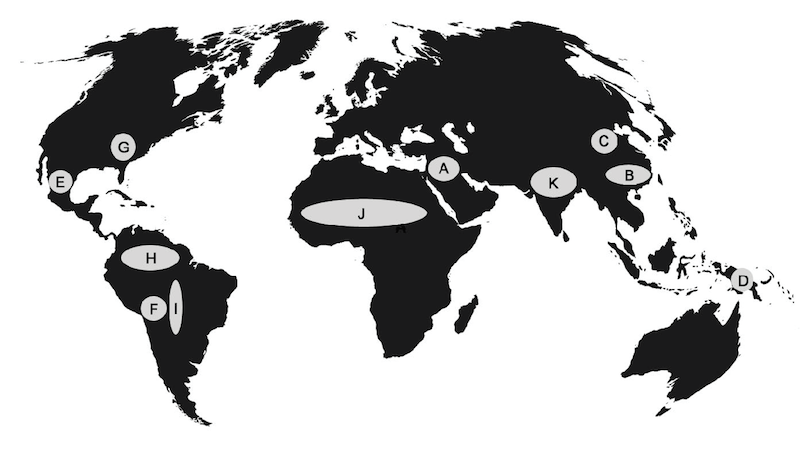The Technology of Agriculture
Episode #6 of the course Technologies that transformed humanity by Richard L. Currier, PhD
As prehistoric farmers settled down to live in permanent villages, the ancient practice of nomadic hunting and gathering began to disappear. Eventually, living in one place led to the accumulation of wealth, the formation of economic classes, the concept of children as property, and the suppression of female sexuality.
Agriculture Springs Up All over the World
When the last ice age ended about 12,000 years ago, human societies on every continent except Europe began domesticating wild plants and animals and raising them for food.
• Wheat, barley, flax, peas, cattle, sheep, goats, and pigs were domesticated in the Middle East and India.
• Rice, chickens, pigs, cattle, and water buffalos were domesticated in Asia.
• Millet, sorghum, yams, and coffee were domesticated in Africa.
• Yams, taro, and bananas were domesticated in New Guinea.
• Corn, squash, beans, gourds, and tomatoes were domesticated in North and Middle America.
• Cotton, potatoes, sweet potatoes, peanuts, tobacco, and chili peppers were domesticated in South America.

Agriculture began in many different regions at the end of the last ice age. A – The Middle East; B and C – China; D – New Guinea; E – Mexico; F – The Andes; G – North America; H – Equatorial South America; I – The Amazon; J – Africa; K – India.
Agriculture gradually spread from its places of origin into neighboring societies, eventually taking root in most of the inhabited world. By 1900 AD, only a few scattered tribes of nomads continued to practice hunting and gathering in the world’s most remote deserts, jungles, and Arctic wastelands.
Farming societies soon produced a food surplus, allowing some people to give up farming and specialize in crafts such as carpentry, weaving, and pottery. Before long, some farming villages grew into thousands of inhabitants.
The Rise of Material Wealth
Dependent on crops that grew in certain favorable locations, agricultural people could not simply pack up and move whenever it suited them. Their new “sedentary” way of life triggered revolutionary changes in human society.
Nomads almost never regarded the land they lived on as their “property.” The personal property of hunters and gatherers was usually limited to what they could actually carry from place to place. So, differences in material wealth remained minimal.
Agriculture changed all of this. The fertile fields that produced food year after year came to be regarded as the “property” of the families that farmed them. Permanent dwellings were inhabited for decades and enlarged by successive generations. Material possessions piled up without concern for having to move them from place to place. And when children began to inherit the goods and property of their parents, hereditary class systems came into existence.
Children as Property
The children of nomads were useless for hunting wild game and almost equally useless for gathering vegetable foods. Thus, they usually remained at camp, watched over by people too old to go hunting or gathering. And while hunter-gatherers’ children were objects of affection and a source of pride and amusement, they “belonged” not to their parents, but instead to the tribal “clans” of extended families.
The children of farmers, on the other hand, were economically useful. They could tend crops and watch animals, contributing significantly to their family’s wealth. Over time, as children were increasingly regarded as the “property” of their immediate families, marriage became formalized and increasingly permanent.
The Menace of the Sexual Woman
Among hunter-gatherers, marriage was very informal. And because sexual partnerships changed often, the biological father’s identity was often unknown. At the same time, the sexual prowess of nomadic women—which renewed and replenished the tribe with new generations—was celebrated and valued as an asset to the community. Nomads typically regarded female chastity (when it occurred at all) as a physical or mental disorder.
But when the exact parentage of children determined the land and property they would inherit, the sexual freedom women formerly enjoyed became a threat to the inheritance of family property. Thus, farmers tend to regard premarital chastity as a virtue, and the sexual woman ultimately came to be regarded as a menace to the social order—an attitude that persisted until modern times.
In tomorrow’s lesson, you will learn how the “technologies of interaction” enabled people to interact over time and space, develop cities, and create the first civilizations.
Recommended reading
Cultural Responses to Climate Change during the Late Holocene
Was Agriculture Impossible during the Pleistocene but Mandatory during the Holocene?
Recommended book
The Agricultural Revolution in Prehistory by Graeme Barker
Share with friends
